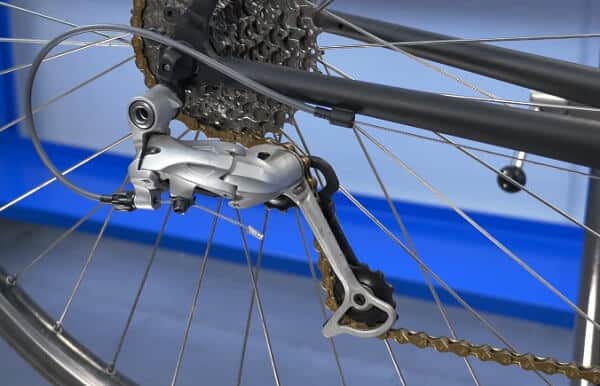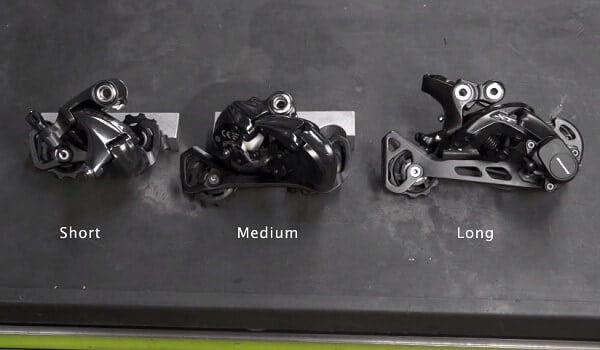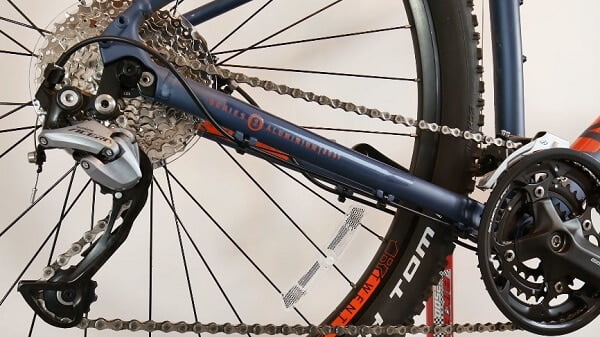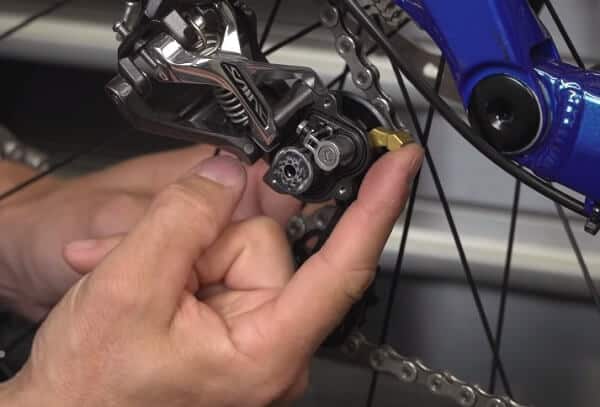Rear derailleurs are an important component found on bikes. You may have noticed that there are some derailleurs with a long cage and some with a short cage. There are even medium cage derailleurs available. So what exactly are the differences between these cage lengths? We will answer this and a bunch of other questions in this article.
A long cage derailleur can maintain tension in the chain for a larger gearing range. They are typically found on mountain bikes and bikes with triple front chainrings. A short cage derailleur is used on many road and gravel bikes. They can only be used on bikes with a low gear range. Short cages have the advantage of being lighter and less prone to damage. The ideal derailleur cage length will depend on a few factors discussed in this article.
What a derailleur cage does
We all know that a rear derailleur is used to shift the chain between different sprockets/cogs of the cassette. The cage of a derailleur is the part that you see hanging out. The purpose of the derailleur cage is to pick up slack in the chain and maintain tension. Without this, there would be a lot of issues, such as the chain falling off the crankset. The cage can come in three different lengths – long, medium, and short.

Derailleur cage length: long, medium, and short
The cage length of a derailleur is the distance between the two small idler gears known as the tension pulley (T-pulley) and the gear pulley (G-pulley). As stated, there are long cages, medium cages, and short cages. Naturally, a longer cage can take up more slack in the chain. But a short cage derailleur is lighter and has less of a chance of suffering impacts.
The reason why there are different cage lengths is that the number and range of gears vary a lot from one kind of bike to another. The bigger the range between the extreme positions of a bike’s gear, the longer the cage needs to be to pick up the extra slack.
Long cage derailleurs are mostly used in mountain bikes which have a large range between the cogs in the rear cassette. Any other bike with triple chainrings at the front may also feature a long cage. Additionally, they can be used in pretty much all bikes without any issues in gear changing.
Short cage derailleurs can be found on road bikes that have a double or single chainring. Road bikes also have a smaller gearing range in the cassette. Moreover, the size of a short cage makes it lightweight and aerodynamic, which is ideal for road cycling.
Medium cage derailleurs are, as you can tell, in between a short and long cage derailleur. They are more versatile and can be used in both mountain and road bikes, given that certain conditions are met.

How to determine what cage length you need
Now the question arises – which derailleur cage length should you use? This will mainly depend on the chain wrap capacity of your crankset. However, there are other things that you should take into account as well. Many riders also have preferences regarding how the derailleur feels and performs, which actually can be affected by the cage length. We have talked about this in the F.A.Q.s section below. The following are 3 simple steps to help you determine your required cage length:
➥ Here, you’ll know in details how you’re supposed to calculate the capacity of the rear derailleurs
1. Calculate chain wrap capacity
This is also known as the drivetrain capacity, total capacity, or chain capacity. It can be calculated using a simple formula:-
Chain-wrap capacity = (largest cog teeth – smallest cog teeth) + (largest chainring teeth – smallest chainring teeth)
For example, if you have triple chainrings with 40-30-22T, the number of teeth on the largest chainring is 40 and on the smallest one is 22. Let’s also say that you have an 11-32T rear cassette which means 32 teeth on the largest cog and 11 on the smallest. Therefore, your chain wrap capacity is (32 – 11) + (40 – 22) = 39. If the teeth number is not mentioned anywhere, you can simply count them.
2. Check derailleur specs
After you’ve found the chain wrap capacity, you need to make sure that the derailleur capacity is not less than this. As long as it is more than (or at least equal to) the chain wrap capacity, it will be fine. Also, you need to check the maximum sprocket size for the derailleur. This limits the size of the largest sprocket on the cassette. If the sprocket is too large, the derailleur won’t be able to shift gears. Both the derailleur capacity and the maximum sprocket size will usually be mentioned in the spec sheet.
3. Ensure that the chain length is appropriate
Finally, you should ensure that the chain itself is at the right length. If it is too short, the derailleur is pulled up so much that it physically cannot get the chain up to the largest cog. Conversely, if it is too long, the derailleur won’t be able to maintain enough tension in the chain.

Frequently Asked Questions
Q1. Does cage length affect performance?
Ans.: Both short and long cage derailleurs have their pros and cons. A longer cage can accommodate a wider gearing range which translates to less slack in your bike’s chain and a chain line that’s more stable. On the other hand, a smaller cage is lightweight, less prone to damage, and often offers snappy gear changes. Ultimately, you should go with a cage length that is compatible with your crankset and also delivers the kind of performance that you prefer.
Q2. Which brand’s rear derailleur should I use?
Ans.: Nearly all rear derailleurs around the world are made by either Shimano, SRAM, or Campagnolo. You should stick to the brand that matches your drivetrain since there will be compatibility issues. Besides, all of them produce excellent products. It is also appropriate that you run a derailleur that is compatible with the number of gears (speed) on your cassette (normally 9, 10, or 11 speed). You can find this compatibility clearly labeled on the product description page. Each manufacturer has a different naming system for their cage lengths which is given below:-
| Cage Length | Shimano | SRAM | Campagnolo |
|---|---|---|---|
| Short cage | SS | Short | Short |
| Medium cage | GS | Medium | Medium |
| Long cage | SGS | WiFli/Eagle | Triple |
➥ Also, we suggest, you have a look at our reviews for the Shimano Altus RD-M310.
Q3. Should I use a medium cage or a long cage for mountain biking?
Ans.: Mountain bikers almost always need longer cages because of the wider gear range of mountain bike drivetrains. However, the problem with this is that a large component is hanging off the bike while maneuvering between rocks, shrubs, and roots. Therefore, it is better to go with a medium cage derailleur or as short a cage as allowed by your drivetrain. That way you can reduce the likelihood of damaging the derailleur.
Q4. What is a clutch derailleur?
Ans.: Clutch derailleurs are the same as regular derailleurs but with an added mechanism. The ‘clutch’ mechanism dampens the movement of the derailleur cage, essentially making it harder to extend the cage. This feature is useful for mountain biking where the rough ground may cause the derailleur to bounce a lot and cause a chain slap. This makes a lot of noise and might result in the chain falling off the chainrings. The clutch significantly restricts this movement. Shimano clutch derailleurs have the option to turn on/off the clutch which might come in handy sometimes.

Conclusion
Those were the differences between the various derailleur cage lengths. You should now have a good idea about how to pick the right cage length for your bike. Despite all the information we have provided, choosing the derailleur cage length is, in essence, very simple. As long as you follow the guidelines we have given, finding the right derailleur should not be too difficult.
